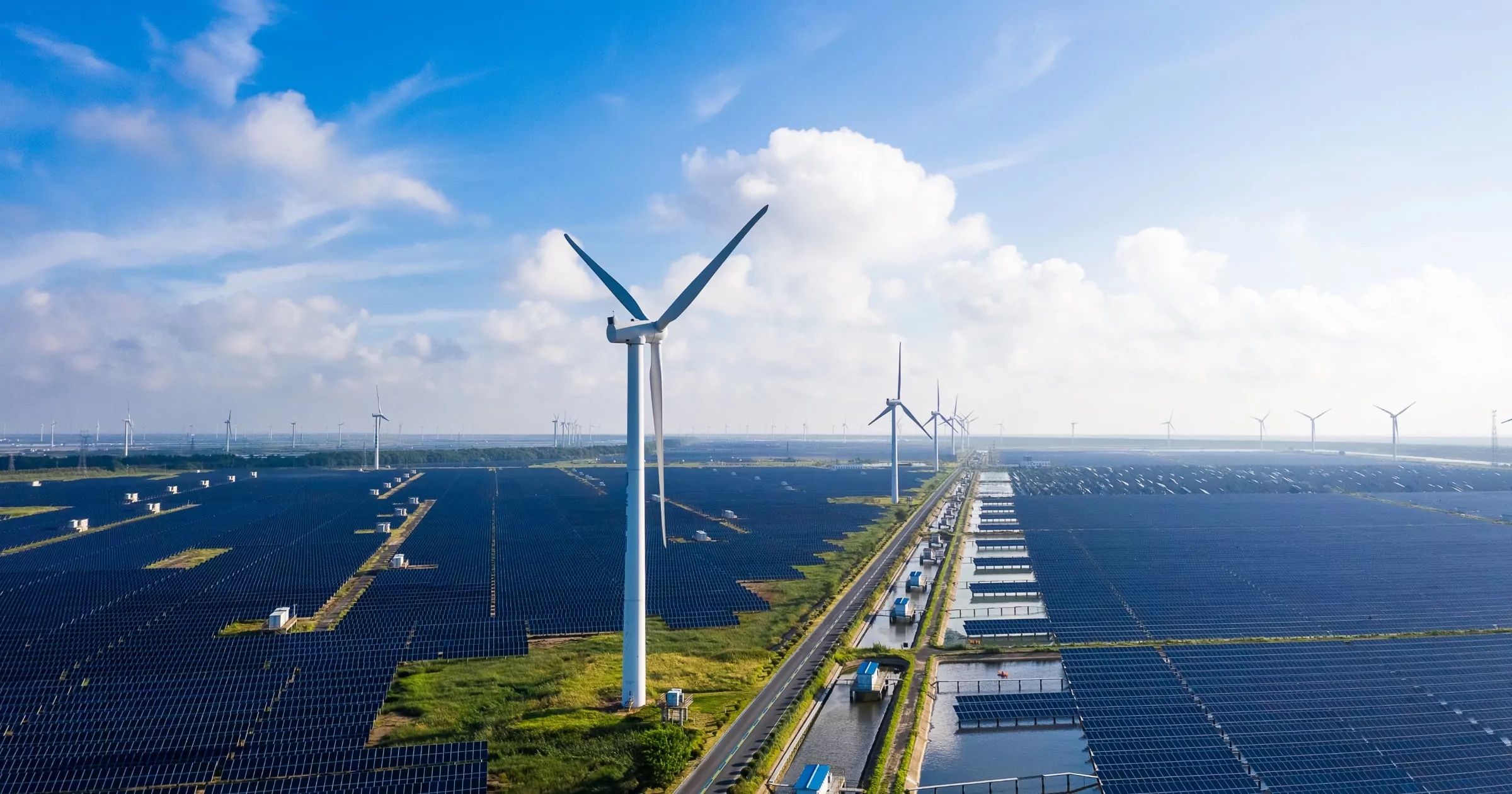
Renewable energy is critical to combatting climate change and global warming. The use of clean energy and renewable energy resources—such as solar, wind and hydropower—originates in early human history; how the world has harnessed power from these resources to meet its energy needs has evolved over time. Here’s a quick look at how different forms of renewable power generation evolved to diversify the global energy sector and the world’s energy supply.
Solar energy
Efforts to harness the power of the sun date back to ancient times, when Greeks and Romans used burning mirrors—concave mirrors that concentrate the sun’s rays—to light torches. The world’s first known solar collector, a device that collects solar radiation, was invented in 1767 and later used to cook food. Then, the late 1800s saw the advent of the first commercial solar water heater and the first solar cell, an apparatus that could convert light into electricity.
According to the United Nations’ Intergovernmental Panel on Climate Change, the 1950s marked the modern age of solar research with the formation of the International Solar Energy Society and more research and development into solar energy by multiple industries. By the early 1960s solar thermal energy (the concentration of sunlight to create heat) was widely used to provide hot water to homes in Israel while solar cells, also known as solar photovoltaic cells, became more efficient. The energy crisis and spiking oil prices of the 1970s propelled solar energy development even further, as more countries invested in solar technology as an alternative energy source to fossil fuels.1
Since the 1990s, continued innovation in energy production and government energy policies, such as tax incentives, have spurred the growth of the solar energy industry and solar energy use. Construction began on large-scale solar power plants, including solar thermal plants, and there was an expansion of distributed solar electricity—electricity generation at residential and business locations through rooftop-mounted solar panels. Solar power also became a source of energy for electric vehicles, with drivers charging their cars through their own home rooftop systems and at solar-powered public charging stations. In 2022, solar photovoltaic generation reached nearly 1300 terawatt hours of electricity, up a record 26% from the year before.2
Demand for solar energy is driven in part by companies seeking to transition to renewable energy sources to meet their ESG goals. For some, solar energy production has become an in-house operation; companies like GPT Group, a diversified property group listed on the Australian Securities Exchange (ASX), have installed on-site solar photovoltaic arrays. To track the results of such efforts, including energy efficiency and emissions reductions, GPT Group deploys an SaaS tool that consolidates enterprise ESG data for analysis and reporting.
Wind energy
Humans have long used wind energy for mechanical purposes. Simple windmills in China were used to pump water and vertical axis windmills were used to grind grain in the Middle East by 200 BC. The Middle East also became home to windmill-powered food production by the 11th century. Later, in Europe, the Dutch adapted windmills for various industrial uses, including making paper and draining lakes. And, in the 19th century, settlers in the Americas used windmills to pump water for agriculture.3
Eventually the use of wind energy shifted from its mechanical applications to electricity generation. Electrical engineer James Blyth is credited with building the world’s first wind turbine in his backyard in Scotland in 1887, while fellow wind energy innovators Charles Brush and Poul la Cour followed up with turbines of their own in Ohio and Denmark, respectively, before the close of the 19th century. Blyth later built a second wind turbine to power a local asylum, Brush used his to power his mansion, and la Cour leveraged wind power to light a school.4
It took decades, however, for wind power generation to achieve commercial-scale viability. As with solar power, the energy crises of the 1970s heightened interest in wind power. Denmark emerged as an early leader in commercial wind power as Danish government policies supported the development of the country’s wind power industry. Then utility-scale wind farms were installed in California in the 1980s, followed by wind farms in Germany and Spain in the 1990s.
Today wind turbines around the world produce more than 2,100 terawatt hours (TWh) of electricity a year. While most turbines are located on land, offshore wind farms have played an increasing role in global electricity generation in recent years, accounting for 18% of wind capacity growth in 2022.5
Hydropower
As the prefix “hydro” suggests, hydropower is the energy derived from water—specifically, the flow of water. As with wind energy, humans have long taken advantage of the mechanical applications of hydropower. The ancient Greeks, for example, used hydropower to turn water wheels that ground wheat into flour.6
The use of hydropower to generate electricity, however, didn’t become commonplace until much later. Innovation in water turbine technology took place throughout the 1800s, including the invention of the Francis turbine by British–American engineer James Francis, which remains widely used today. By the late 1800s, such innovation culminated in hydroelectric projects ranging from one that powered a single lamp in a home in England in 1878 to, four years later, a full-fledged hydroelectric power station with 12.5 kW capacity that served two paper mills and one residence.6, 7
Countries around the world soon became home to hydropower projects, from Australia to Canada. After World War II, hydropower development accelerated further, with state-owned projects in Europe, North America, Japan and the former Soviet Union. Today, the two largest hydroelectric projects in the world are dams in South America and China: The 14,000 megawatt Itaipu Dam, at the Paraná River on the border of Brazil and Paraguay, and 22,500 megawatt Three Gorges Dam, along China’s Yangtze River.
Hydropower plays an important role not only in generating electricity but also in storing energy. Through pumped storage hydropower, an energy storage model dating back to the 1890s, water flows between two water reservoirs at different elevations. When power is plentiful from other sources (such as solar and wind farms), power is used to pump water into an upper reservoir. As necessary, water is released from the upper reservoir back into the lower reservoir to generate electricity, “basically filling in the gaps during peak demand,” according to the U.S. Department of Energy (DOE).8
Geothermal energy
Geothermal energy stems from heat within the Earth. It can be used to heat and cool buildings and for generating electricity (geothermal power). Humans have harnessed geothermal energy since at least the Paleolithic period, when hot springs were used for bathing. The first known commercial use of geothermal energy, however, didn’t take place until 1830, when people could pay a dollar to use baths fed by three hot springs in the city of Hot Springs, Arkansas. Some 60 years later, the worst’s first district heating system was installed in Boise, Idaho, pumping water from hot springs to more than 200 homes and businesses.9
For all the geothermal innovation in the United States, however, Europeans established the first geothermal power plant. In 1904, an Italian prince, Piero Conti, powered light bulbs through a geothermal power experiment that harnessed steam from Tuscany’s Larderello geothermal field. His work later culminated in the construction of a steam-fed commercial power plant in the region.
Today, geothermal energy systems help meet a significant portion of energy demand in countries around the world. Historically, the development of geothermal power plants has been limited by natural conditions—a prospective location needed to have natural heat, fluid to carry that heat, and pathways through rocks for that fluid to travel. However, some scientists are hopeful that technological advances will empower the construction of geothermal power plants and geothermal energy consumption in more places.
Geothermal energy can be a part of the mix of renewable energy sources used by companies to meet their ESG goals. Celestica, a multinational company specializing in design, manufacturing and supply chain solutions, reduced its dependence on natural gas by transitioning to geothermal power at its facility in Oradea, Romania. The company, which has also invested in on-site solar photovoltaic systems, uses software to streamline data on its renewable energy efforts.
Bioenergy
Bioenergy is a renewable energy source derived from biomass, organic materials from plants and animals. People have taken advantage of bioenergy throughout human history by burning wood, which provided heat and light. Wood was the main fuel for cooking and heating, while another form of biomass—plant oil—was the primary fuel for lighting lamps before the 19th century.
Biomass can be converted into liquid fuels known as biofuels. The two most common biofuels are ethanol, a type of alcohol, and biodiesel, which is produced through a chemical process known as transesterification using vegetable oils or animal fats. Biofuel use in internal combustion engines dates back over a century. Rudolf Diesel, the German mechanical engineer who invented the diesel engine in 1897, experimented with vegetable oils in his work, while ethanol is listed by the U.S. Department of Energy as one of the first automotive fuels. Interest in ethanol, particularly as a gasoline additive, spiked following the 1970s energy crises and rising oil prices.
Biofuel production techniques and feedstock continue to evolve. Scientists are working on using food industry waste, plant waste and algae to overcome supply and land-use limitations associated with crops used for older generations of biofuel.10 In addition, in recent years a biofuel known as renewable diesel has seen increased demand.
Renewable diesel is similar to biodiesel but is produced through a different chemical process. Its popularity is due in part to the fact that it’s a “drop-in” fuel—it can be used in diesel engines without being blended with petroleum diesel. In 2023, for instance, a power generation equipment manufacturer in France announced it was switching from petroleum diesel to renewable diesel for generator testing, resulting in a significant decrease in greenhouse gas emissions.
The future: technology for renewable energy transitions
As more companies transition to renewable energy to meet regulatory requirements and ESG goals, data management is taking center stage to ensure sustainability efforts stay on track. ESG reporting software from IBM Envizi™ integrates a suite of products that help you capture and manage all your ESG data in a single system of record and report with confidence knowing that your data is auditable and finance-grade.
1Direct Solar Energy. In IPCC Special Report on Renewable Energy Sources and Climate Change Mitigation. (link resides outside ibm.com), IPCC, 2011.
2Solar PV. (link resides outside ibm.com), International Energy Agency, 2023.
3Wind Energy. In IPCC Special Report on Renewable Energy Sources and Climate Change Mitigation. (link resides outside ibm.com), IPCC, 2011.
4“Let There Be Wind.” (link resides outside ibm.com), History Today, Aug. 11, 2021.
5Wind. (link resides outside ibm.com), International Energy Agency, 2023.
6Hydropower. In IPCC Special Report on Renewable Energy Sources and Climate Change Mitigation. (link resides outside ibm.com), IPCC, 2011.
7“A brief history of hydropower.” (link resides outside ibm.com), International Hydropower Association.
8Pumped Storage Hydropower. (link resides outside ibm.com), Office of Energy Efficiency & Renewable Energy, U.S. Department of Energy.
9Energy Saver History Timeline: Geothermal Energy (link resides outside ibm.com), Energy Saver, U.S. Department of Energy.
10“The potential of biofuels from first to fourth generation.” (link resides outside ibm.com), PLOS Biology, March, 2023
Was this article helpful?
YesNo
More from Sustainability

February 8, 2024
The history of ESG: A journey towards sustainable investing
4 min read – The term ESG, or environmental, social and governance, is well-known in the investor community. It refers to a set of metrics used to measure an organization’s environmental and social impact and has become increasingly important in investment decision-making over the years. But while the term ESG was first coined in 2004 by the United Nations Global Compact, the concept has been around for much longer. The roots of responsible investment In the 1970s, socially responsible investing (SRI) emerged as a…

February 8, 2024
The history of climate change
6 min read – Tackling global climate change and tracking greenhouse gas emissions has become an all-hands-on-deck endeavor. The World Bank recently launched an initiative, in collaboration with NASA and the European Space Agency, to collect and organize satellite-based measurements of concentrations of greenhouse gases in the atmosphere.1 Back on Earth’s surface, companies around the world are also tracking greenhouse gas emissions—the ones produced by their businesses and value chains. Some are using software tools to gauge their progress in achieving reductions in carbon…

February 7, 2024
Sustainability trends: 5 issues to watch in 2024
5 min read – In 2024, sustainability is taking center stage. Efforts to track and reduce emissions, environmental impact and contributions to climate change are no longer rare or optional; instead, they’ve become the norm. Businesses, governments and individuals now see sustainability as a global imperative. Advanced technologies, more stringent reporting standards and stronger support from stakeholders are building momentum for eco-friendly initiatives and the incentives that encourage them. Here’s what to watch: Net zero: The race moves forward The global focus on achieving…

February 5, 2024
Transforming the future: A journey into model-based systems engineering at Singapore Institute of Technology
5 min read – In the dynamic cityscape of Singapore, a pioneering initiative is unfolding at the Singapore Institute of Technology (SIT). A group of 56 students has embarked on a unique journey into the world of model-based systems engineering (MBSE). Under the mentorship of Marco Forlingieri, associate faculty member at SIT and ASEAN Engineering Leader from IBM Singapore, students engaged in a hands-on exploration of IBM® Engineering Systems Design Rhapsody®. This course stands as Singapore’s only dedicated MBSE academic offering. IBM: Not only…
IBM Newsletters
Get our newsletters and topic updates that deliver the latest thought leadership and insights on emerging trends.
Subscribe now More newsletters
- SEO Powered Content & PR Distribution. Get Amplified Today.
- PlatoData.Network Vertical Generative Ai. Empower Yourself. Access Here.
- PlatoAiStream. Web3 Intelligence. Knowledge Amplified. Access Here.
- PlatoESG. Carbon, CleanTech, Energy, Environment, Solar, Waste Management. Access Here.
- PlatoHealth. Biotech and Clinical Trials Intelligence. Access Here.
- Source: https://www.ibm.com/blog/renewable-energy-history/
- :has
- :is
- :not
- $UP
- 00
- 000
- 1
- 100
- 11
- 11th
- 12
- 1300
- 14
- 19th
- 2%
- 200
- 2011
- 2021
- 2022
- 2023
- 2024
- 22
- 29
- 30
- 300
- 33
- 4
- 40
- 400
- 5
- 500
- 6
- 60
- 7
- 8
- 9
- a
- academic
- accelerated
- According
- Accounting
- Achieve
- achieving
- adapted
- addition
- additive
- advanced
- advances
- ADvantage
- advent
- Advertising
- After
- against
- age
- agency
- agriculture
- Alcohol
- alice
- All
- along
- also
- alternative
- america
- Americas
- amp
- an
- analysis
- analytics
- Ancient
- and
- animal
- animals
- announced
- Another
- applications
- ARE
- arkansas
- around
- article
- AS
- Asean
- Associate
- associated
- Association
- ASX
- At
- Atmosphere
- Aug
- Australia
- Australian
- author
- automotive
- Axis
- back
- Bank
- BE
- became
- become
- been
- before
- began
- being
- between
- biology
- biomass
- Blog
- blogs
- Blue
- border
- Brazil
- BRIDGE
- Building
- buildings
- built
- burning
- business
- businesses
- but
- button
- by
- california
- CAN
- Canada
- Capacity
- capture
- carbon
- card
- Cards
- carry
- cars
- CAT
- Category
- cell
- Cells
- Center
- center stage
- Century
- chain
- chains
- change
- charging
- charging stations
- Charles
- check
- chemical
- China
- Chinas
- circles
- CIS
- City
- cityscape
- class
- Climate
- Climate change
- Close
- coined
- collaboration
- collect
- collector
- collects
- color
- COM
- commercial
- Common
- community
- compact
- Companies
- company
- concentrate
- concentration
- concept
- confidence
- Consolidates
- construction
- consumption
- Container
- Conti
- continue
- continued
- contributions
- convert
- converted
- cooking
- Cool
- could
- countries
- country’s
- cour
- course
- Crashing
- create
- crises
- crisis
- critical
- crops
- CSS
- custom
- danish
- data
- data management
- Date
- Dates
- Dating
- decades
- Decision Making
- decrease
- dedicated
- Default
- definitions
- deliver
- Demand
- Denmark
- Department
- Department of Energy
- Department Of Energy (DOE)
- dependence
- deploys
- Derived
- description
- Design
- Designer
- Development
- device
- diesel
- different
- different forms
- distributed
- district
- diversified
- diversify
- DOE
- Dollar
- driven
- drivers
- due
- during
- Dutch
- dynamic
- Early
- earth
- East
- Eco-friendly
- efficiency
- efficient
- efforts
- Electric
- electric vehicles
- electricity
- embarked
- emerged
- emerging
- Emissions
- empower
- encourage
- endeavor
- energy
- Energy Consumption
- energy crisis
- energy efficiency
- energy use
- engaged
- Engine
- engineer
- Engineering
- Engines
- England
- ensure
- Enter
- Enterprise
- environmental
- equipment
- ESG
- established
- Ether (ETH)
- Europe
- European
- European Space Agency
- Europeans
- Even
- evolve
- evolved
- example
- exchange
- Exit
- expansion
- experiment
- exploration
- Facility
- fact
- false
- Farms
- February
- Fed
- fellow
- field
- filling
- First
- flow
- Flows
- fluid
- Focus
- follow
- followed
- following
- fonts
- food
- For
- form
- formation
- Former
- forms
- Forward
- fossil
- fossil fuels
- four
- Fourth
- France
- Francis
- from
- Fuel
- fuels
- full-fledged
- further
- future
- gaps
- GAS
- gasoline
- gauge
- generate
- generating
- generation
- generations
- generator
- geothermal energy
- German
- Germany
- get
- Global
- global warming
- Goals
- governance
- Government
- Governments
- greenhouse gas
- Greenhouse gas emissions
- Grid
- Ground
- Group
- Growth
- hands-on
- harness
- Have
- Heading
- Heart
- height
- heightened
- help
- helpful
- his
- historically
- history
- Home
- Homes
- hopeful
- HOT
- HOURS
- How
- However
- HTTPS
- human
- Humans
- Hydropower
- IBM
- ICO
- ICON
- IEA
- ii
- image
- Impact
- imperative
- important
- in
- Incentives
- Including
- increased
- increasing
- increasingly
- index
- individuals
- industrial
- industries
- industry
- Initiative
- initiatives
- Innovation
- innovators
- insights
- installed
- instance
- instead
- Institute
- Integrates
- interest
- internal
- International
- into
- Invented
- Invention
- invested
- investing
- investment
- investor
- Israel
- issues
- IT
- Italian
- ITS
- james
- Japan
- journey
- jpg
- Knowing
- known
- la
- lakes
- Land
- large
- large-scale
- largest
- Late
- later
- latest
- launched
- leader
- Leadership
- least
- leveraged
- light
- Lighting
- like
- limitations
- Limited
- LINK
- Liquid
- Listed
- local
- locale
- located
- location
- locations
- Long
- longer
- Look
- looking
- lower
- Main
- Making
- manage
- management
- mansion
- Manufacturer
- manufacturing
- March
- Marco
- marked
- materials
- max-width
- measure
- measurements
- mechanical
- Meet
- member
- Mentorship
- method
- Metrics
- Middle
- Middle East
- mills
- min
- minutes
- mix
- Mobile
- model
- Modern
- Momentum
- more
- more efficient
- most
- moves
- much
- multinational
- multiple
- Nasa
- Nations
- Natural
- Natural Gas
- Navigation
- nearly
- necessary
- needed
- needs
- net
- New
- New York
- Newsletters
- NIH
- no
- North
- north america
- nothing
- now
- ocean
- of
- off
- offering
- Office
- Ohio
- Oil
- oils
- older
- on
- ONE
- ones
- only
- operation
- optimized
- or
- organic
- Other
- our
- out
- outside
- over
- Overcome
- own
- page
- panel
- panels
- Paper
- Paraguay
- part
- particularly
- pathways
- Pay
- Peak
- People
- period
- Petroleum
- PHP
- Pioneering
- Place
- Places
- plant
- plants
- plato
- Plato Data Intelligence
- PlatoData
- played
- plays
- plugin
- policies
- policy
- popularity
- portion
- position
- Post
- potential
- power
- power plants
- powered
- Prices
- primary
- Prince
- process
- produce
- Produced
- Production
- Products
- Progress
- projects
- propelled
- property
- prospective
- provide
- provided
- public
- pump
- pumping
- purposes
- Quick
- Race
- Radiation
- ranging
- RARE
- reached
- Reading
- recent
- recently
- record
- reduce
- Reduced
- reductions
- refers
- region
- regulatory
- released
- remains
- Renewable
- renewable energy
- report
- Reporting
- Requirements
- research
- research and development
- Residence
- residential
- resides
- Resources
- responsible
- Responsible Investing
- responsive
- resulting
- Results
- rising
- River
- robots
- Role
- Romania
- roots
- s
- saw
- School
- scientists
- Scotland
- Screen
- scripts
- Second
- sector
- Securities
- Securities Exchange
- see
- seeking
- seen
- seo
- served
- set
- sharing
- shifted
- significant
- similar
- Simple
- since
- Singapore
- Singapore’s
- single
- sit
- site
- small
- Social
- Social impact
- socially
- Society
- Software
- solar
- Solar cells
- solar energy
- solar panels
- Solar Power
- solar-powered
- Solutions
- some
- Soon
- Source
- Sources
- South
- South America
- soviet
- Space
- Spain
- special
- specializing
- Sponsored
- squares
- Stage
- stakeholders
- standards
- stands
- start
- state-owned
- States
- station
- Stations
- stay
- Steam
- stems
- storage
- streamline
- stringent
- stronger
- Student
- Students
- subscribe
- such
- Suggests
- suite
- Sun
- sunlight
- supply
- supply chain
- support
- Supported
- Surface
- Sustainability
- sustainable
- Sustainable Investing
- SVG
- system
- system of record
- Systems
- Systems Design
- Take
- taken
- taking
- tax
- techniques
- technological
- Technologies
- Technology
- term
- tertiary
- Testing
- than
- thanks
- that
- The
- The Future
- the world
- their
- Them
- theme
- then
- There.
- thermal
- These
- this
- thought
- thought leadership
- three
- Through
- throughout
- time
- timeline
- times
- Title
- to
- today
- took
- tool
- tools
- top
- topic
- torches
- towards
- track
- Tracking
- transforming
- transition
- transitioning
- travel
- Trends
- turbine
- TURN
- two
- type
- u.s.
- under
- unfolding
- union
- unique
- United
- united nations
- United States
- until
- Updates
- URL
- use
- used
- uses
- using
- value
- various
- Vehicles
- vertical
- viability
- View
- W
- war
- was
- Waste
- Watch
- watching
- Water
- waves
- well-known
- were
- What
- when
- which
- while
- WHO
- widely
- will
- wind
- wind energy
- wind farms
- wind power
- wind turbine
- windmills
- window
- with
- within
- without
- wood
- WordPress
- Work
- working
- world
- World Bank
- world’s
- written
- year
- years
- york
- you
- Your
- zephyrnet
- zero












